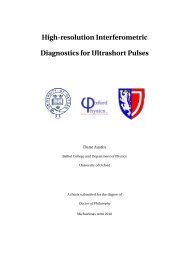Problem Set [pdf]
Problem Set [pdf]
Problem Set [pdf]
Create successful ePaper yourself
Turn your PDF publications into a flip-book with our unique Google optimized e-Paper software.
Condensed Matter Option SUPERCONDUCTIVITY <strong>Problem</strong>s 2013<br />
1. (a) Describe briefly the Meissner effect in a superconductor. Explain why a superconductor<br />
cannot be considered as a merely a metal with perfect electrical conduction.<br />
(b) The charge carriers in superconductor (mass m ∗ , charge −q, number n per unit volume)<br />
carry a current density J. By equating the canonical momentum p = m ∗ v + qA to zero, derive<br />
the London equation<br />
∇ × J = − B<br />
µ 0 λ 2 ,<br />
and find λ in terms of q, n and m ∗ . By considering a magnetic field applied tangentially to the<br />
x = 0 plane, show that this result leads to the Meissner effect in a superconductor located in<br />
the half space x > 0.<br />
(c) Estimate λ for a typical superconductor using reasonable values of n and m ∗ .<br />
2. Lead has a critical field B c of about 0.07 T at 4.2 K. A magnetic field is applied along the axis<br />
of a lead cylinder which has an axial hole of 1 cm inner diameter. The applied field is reduced<br />
to zero from an initial value of 1 T.<br />
(a) Draw sketches to show the lines of flux at the various stages of this process.<br />
(b) Estimate the magnetic dipole moment per unit length of the cylinder with its trapped flux.<br />
Is flux quantization in this problem something about which to be concerned<br />
(c) Calculate the magnitude of the surface currents per unit length circulating within the surface<br />
of the central hole. Estimate the current density within a London penetration depth of the<br />
surface.<br />
(d) A sample of tin containing a hole of diameter 10 −5 m is cooled through its transition<br />
temperature in a magnetic field of 10 −4 T applied parallel to the axis of the hole. Calculate the<br />
number of trapped flux quanta.<br />
3. Empirically it is found that the temperature dependence of the critical field B c of a type-I<br />
superconductor is given by<br />
( ) ]<br />
T<br />
2<br />
B c = B 0<br />
[1 − .<br />
T c<br />
Use this to show that the entropy S s per unit volume of the superconducting state is lower<br />
than that of the normal state S n . Furthermore, show that S n − S s = aT − bT 3 where a and b<br />
are constants, and that S n = S s when T = T c .<br />
Sketch the heat capacity of such a superconductor with B = 0 as a function of T . Show that<br />
the drop in heat capacity at T c has magnitude ∆C = 4B 2 0 /(µ 0T c ) per unit volume. Calculate<br />
∆C for a conventional superconductor with B 0 = 0.08 T and T c = 7 K.<br />
4. (a) What is the evidence for the energy gap in a superconductor<br />
(b) Why does the energy gap lead to superconductivity in certain metals but to large resistivity<br />
in intrinsic semiconductors<br />
(c) Explain why an energy gap might be expected in superconductors on the basis of the BCS<br />
theory
5. Why do superconductors conduct electricity with zero resistance Why do they have poor<br />
thermal conductivity<br />
6. Assuming a coherent ground state, show that any magnetic flux trapped within a multiply<br />
connected superconductor must be quantized. Derive an expression for the flux quantum.<br />
7. The wave function of the coherent pair state in a superconductor may be written as ψ = √ n e iθ ,<br />
where n is the density of electron pairs. A simplified form of the Schrödinger equation for the<br />
wave functions ψ 1 and ψ 2 on each side of the Josephson junction with potential V across the<br />
junction are<br />
i ˙ψ 1 = T ψ 2 − eV ψ 1<br />
i ˙ψ 2 = T ψ 1 + eV ψ 2 ,<br />
where T is a characteristic of the junction. Show that the current across the junction is given<br />
by<br />
I = −2eṅ 1 = 4eT √ (<br />
n 1 n 2 sin δ(0) + 2eV t )<br />
<br />
where δ(0) is the value of θ 1 − θ 2 at time zero and one can assume |n 1 − n 2 | ≪ (n 1 + n 2 ).<br />
B<br />
I s<br />
I s<br />
A<br />
Consider two such junctions A and B with a magnetic flux Φ threading the loop (see above).<br />
No voltage is applied. Use the condition δ B − δ A = 2eΦ/ + 2mπ, where m is an integer and δ i<br />
is the phase difference across junction i, to show that a superconducting current I s flows where<br />
I s = (−1) m 8eT √ ( ) (<br />
δA + δ B eΦ<br />
n 1 n 2 sin<br />
cos<br />
2<br />
<br />
Explain briefly how this type of device may be used to measure magnetic fields.<br />
)<br />
.


![Problem Set [pdf]](https://img.yumpu.com/33922520/1/500x640/problem-set-pdf.jpg)







![Extended Notes 8 [pdf]](https://img.yumpu.com/50123548/1/190x245/extended-notes-8-pdf.jpg?quality=85)




![Handout 3 [pdf] - University of Oxford Department of Physics](https://img.yumpu.com/46475432/1/190x245/handout-3-pdf-university-of-oxford-department-of-physics.jpg?quality=85)